JDBC学习笔记
JDBC
技术体系
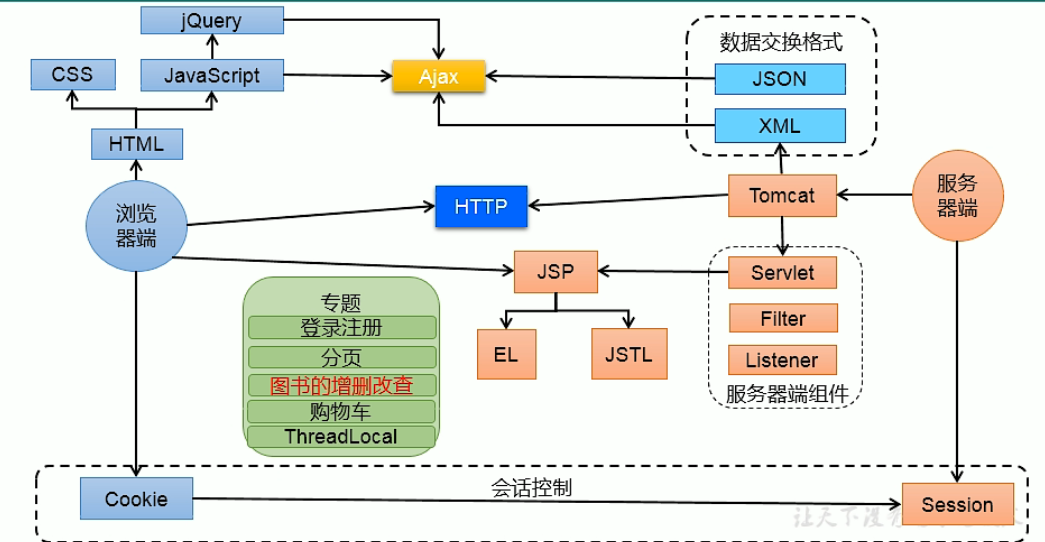
一、概述
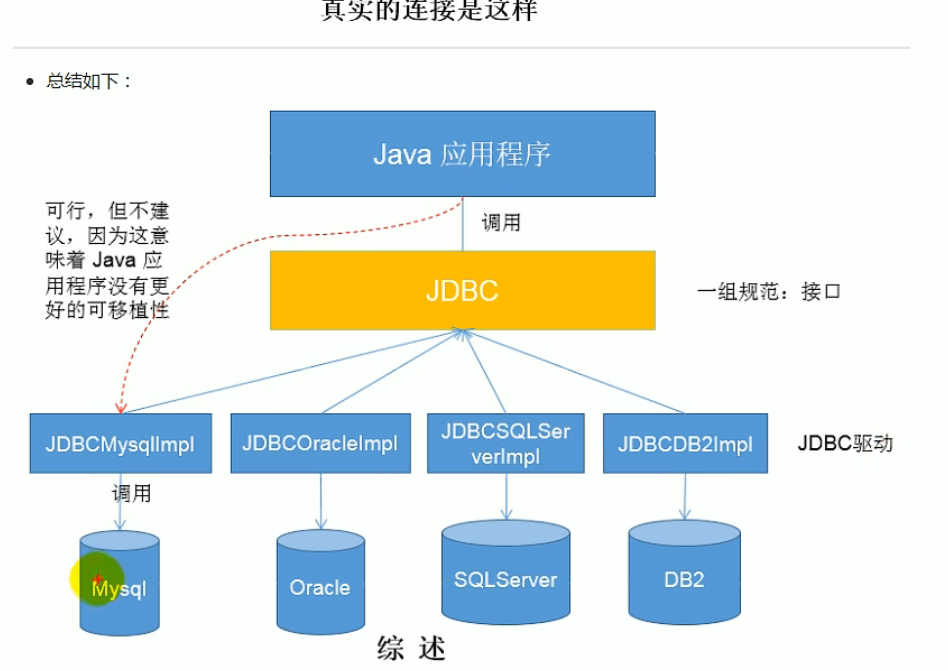
JDBC由java官方定义的一组标准:接口;对应各个数据库厂商实现对应的方法即驱动
JDBC(Java Database Connectivity)是一个独立于特定数据库管理系统、通用的SQL数据库存取和操作的公共接口(一组API),定义了用来访问数据库的标准Java类库,(java.sql,javax.sql)使用这些类库可以以一种标准的方法、方便地访问数据库资源。
在使用JDBC情况下访问数据库
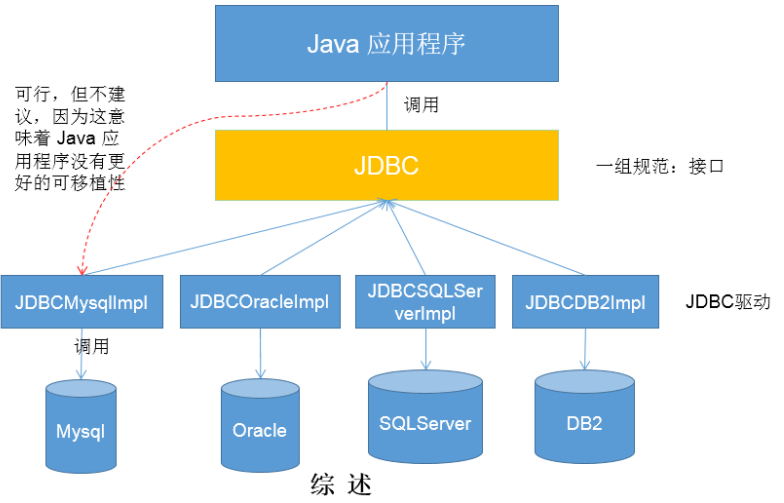
JDBC程序编写步骤
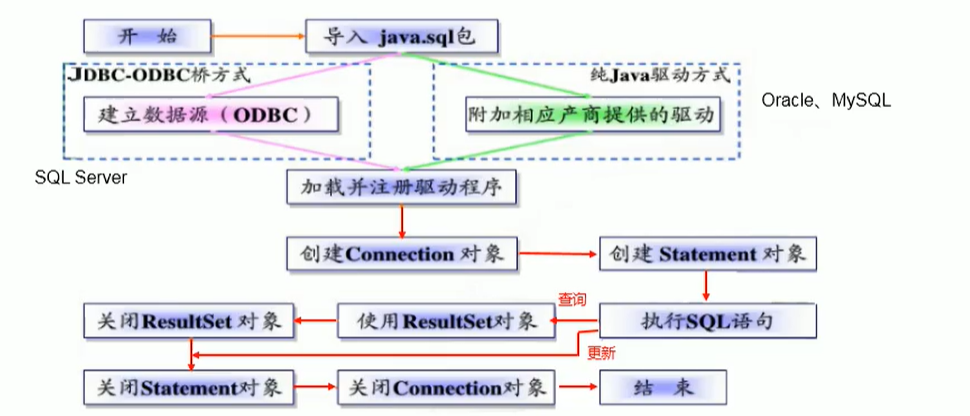
二、获取数据库连接
方式一到五,1-4作为过程存在,了解即可
方式五
- ```java
/**
* 获取数据库连接
* @return
* @throws Exception
*/
public static Connection getConnection() throws Exception {
// 读取配置文件信息
InputStream ips = ClassLoader.getSystemClassLoader().getResourceAsStream(“jdbc.properties”);
Properties pros=new Properties();
pros.load(ips);
String user = pros.getProperty(“user”);
String password = pros.getProperty(“password”);
String url = pros.getProperty(“url”);
String driverClass = pros.getProperty(“driverClass”);
// 2.加载驱动
Class.forName(driverClass);
// 3.连接
Connection conn = DriverManager.getConnection(url, user, password);
System.out.println(conn);
return conn;
}1
2
3
4
5
6
7
8
9
- 配置文件jdbc.properties存放在src下
- ```xml
user=root
password=123456
url=jdbc:mysql://localhost:3306/test?serverTimezone=GMT
driverClass=com.mysql.cj.jdbc.Driver
- ```java
三、JDBCUtils.java
1 | |
四、使用preparedStatement实现CRUD
4.1 使用statement的问题
- 问题一:存在拼串操作,繁琐
- 问题二:存在SQL注入问题
- SQL 注入是利用某些系统没有对用户输入的数据进行充分的检查,而在用户输入数据中注入非法的 SQL 语句段或命令(如:SELECT user, password FROM user_table WHERE user=’a’ OR 1 = ‘ AND password = ‘ OR ‘1’ = ‘1’) ,从而利用系统的 SQL 引擎完成恶意行为的做法。
- 无法操作Blob类型数据
- 实现批量插入时,效率较低
4.2 使用preparestatement
介绍
- 是statement的子接口
- 使用预编译sql语句
- 可以解决sql注入问题,实现高效的批量操作
通用增删改操作(V1.0)
- ```java
public void update(String sql,Object …args) {
Connection conn = null;
PreparedStatement ps = null;
try {
// 占位符的个数等于可变形参的个数
conn = JDBCUtils.getConnection();
ps = conn.prepareStatement(sql);
for(int i=0;i<args.length;i++){
ps.setObject(i+1,args[i]);
}
// 方式一:如果执行的查询操作又返回结果,此方法返回true;执行增删改,无返回结果,返回false
// ps.execute();
// 方式二:
ps.executeUpdate();
} catch (Exception e) {
e.printStackTrace();
} finally {
JDBCUtils.closeResource(conn,ps);
}
}1
2
3
4
5
6
7
8
9
10
11
12
13
14
15
16
17
18
19
20
21
22
23
24
25
26
27
28
29
30
31
32
33
34
35
36
37
38
39
40
41
42
43
44
45
46
47
48
49
50
51
52
53
54
55
56
57
58
59
60
61
62
63
64
65
66
67
68
69
70
71
72
73
74
75
76
77
78
79
80
- 通用查询操作(V1.0)
- ```java
/**
*
*@author Kong
*@Description 针对不同表的通用查询操作,返回表中的一组记录
*@Date 22:12 2022/5/19
*@Param
*@Return
**/
public <T> List<T> getForList(Class<T> clazz, String sql, Object ...args){
Connection conn = null;
PreparedStatement ps = null;
ResultSet rs = null;
try {
conn = JDBCUtils.getConnection();
ps = conn.prepareStatement(sql);
for(int i=0;i<args.length;i++){
ps.setObject(i+1,args[i]);
}
rs = ps.executeQuery();
ResultSetMetaData rsmd = rs.getMetaData();
int columnCount = rsmd.getColumnCount();
ArrayList<T> list = new ArrayList<>();
while(rs.next()){
T t = clazz.newInstance();
for(int i=0;i<columnCount;i++){
Object value = rs.getObject(i + 1);
String columnLabel = rsmd.getColumnLabel(i + 1);
Field field = clazz.getDeclaredField(columnLabel);
field.setAccessible(true);
field.set(t,value);
}
list.add(t);
}
return list;
} catch (Exception e) {
e.printStackTrace();
} finally {
JDBCUtils.closeResource(conn,ps,rs);
}
return null;
}
public <T>T getForInstance(Class<T> clazz,String sql,Object ...args) {
Connection conn = null;
PreparedStatement ps = null;
ResultSet rs = null;
try {
conn = JDBCUtils.getConnection();
ps = conn.prepareStatement(sql);
for(int i=0;i<args.length;i++){
ps.setObject(i+1,args[i]);
}
rs = ps.executeQuery();
ResultSetMetaData rsmd = rs.getMetaData();
int columnCount = rsmd.getColumnCount();
if(rs.next()){
T t = clazz.newInstance();
for(int i=0;i<columnCount;i++){
Object value = rs.getObject(i + 1);
String columnLabel = rsmd.getColumnLabel(i + 1);
Field field = clazz.getDeclaredField(columnLabel);
field.setAccessible(true);
field.set(t,value);
}
return t;
}
} catch (Exception e) {
e.printStackTrace();
} finally {
JDBCUtils.closeResource(conn,ps,rs);
}
return null;
}
- ```java
两种思想
面向接口编程的思想
ORM思想(object relational mapping)
- 一个数据表对应一个java类
- 表中的一条记录对应java类的一个对象
- 表中的一个字段对应java类的一个属性
sql是需要结合列名和表的属性名来写。注意起别名。
两种技术
- JDBC结果集的元数据:ResultSetMetaData
- 获取列数:getColumnCount()
- 获取列的别名:getColumnLabel()
- 通过反射,创建指定类的对象,获取指定的属性并赋值
- JDBC结果集的元数据:ResultSetMetaData
过程图示
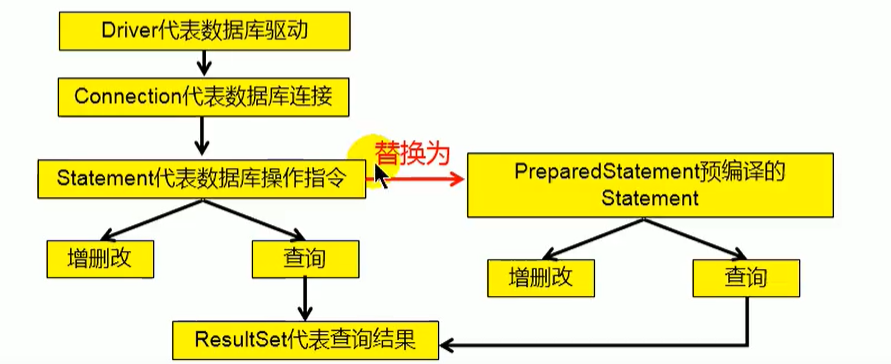
- 查询操作的流程
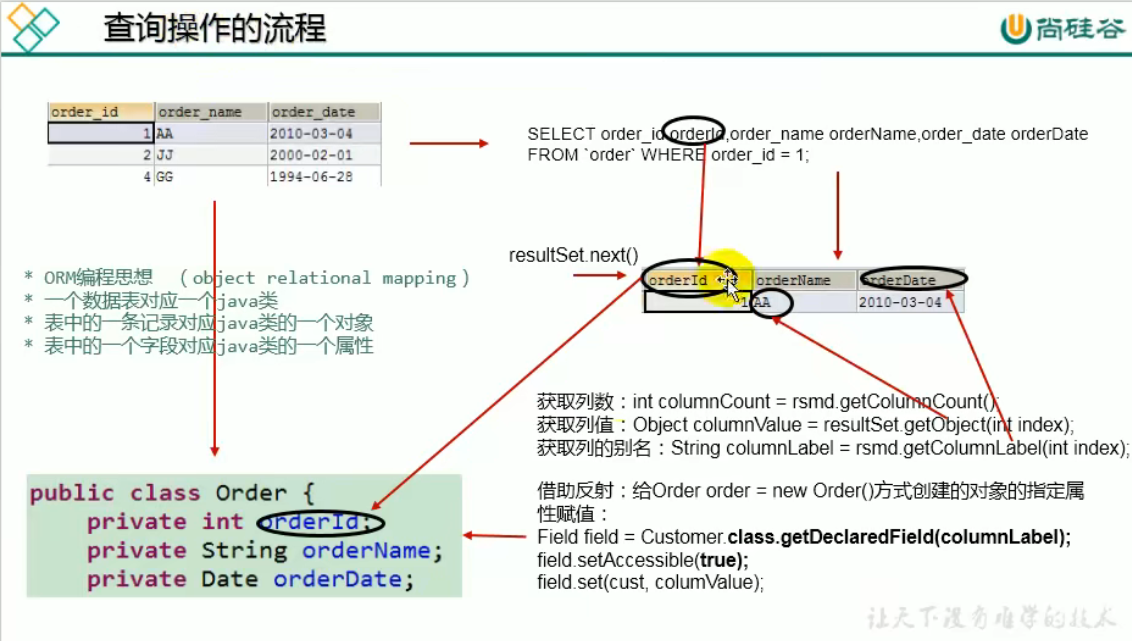
五、操作Blob类型的变量
具体的insert
- ```java
/**
*
*@author Kong
*@Description 向数据表中插入blob信息
*@Date 13:59 2022/5/20
*@Param
*@Return
**/
@Test
public void testInsert() throws Exception {
Connection conn = JDBCUtils.getConnection();
String sql = “insert into customers(name,email,birth,photo) values(?,?,?,?)”;
PreparedStatement ps = conn.prepareStatement(sql);
ps.setObject(1, “孙悟空”);
ps.setObject(2, “sun@qq.com“);
ps.setObject(3, “500-01-01”);
FileInputStream is = new FileInputStream(new File(“src/sun.jpg”));
ps.setBlob(4, is);
ps.execute();
JDBCUtils.closeResource(conn,ps);
}1
2
3
4
5
6
7
8
9
10
11
12
13
14
15
16
17
18
19
20
21
22
23
24
25
26
27
28
29
30
31
32
33
34
35
36
37
38
39
40
41
42
43
44
45
46
47
48
49
50
51
52
53
54
55
56
57
58
- 具体的查询
- ```java
/**
*
*@author Kong
*@Description 从数据表中查询blob信息
*@Date 14:00 2022/5/20
*@Param
*@Return
**/
@Test
public void testQuery() throws Exception {
Connection conn = null;
PreparedStatement ps = null;
InputStream is=null;
FileOutputStream fos=null;
try {
conn = JDBCUtils.getConnection();
String sql = "select id,name,email,birth,photo from customers where id =?" ;
ps = conn.prepareStatement(sql);
ps.setObject(1, 20);
ResultSet rs = ps.executeQuery();
if(rs.next()){
// 方式一
// int id = rs.getInt(1);
// String name = rs.getString(2);
// String email = rs.getString(3);
// Date birth = rs.getDate(4);
// 方式二:更易读,不易出错
int id = rs.getInt("id");
String name = rs.getString("name");
String email = rs.getString("email");
Date birth = rs.getDate("birth");
Customer customer = new Customer(id, name, email, birth);
System.out.println(customer);
// 将文件下载到本地
Blob photo = rs.getBlob("photo");
is = photo.getBinaryStream();
fos = new FileOutputStream("wukong.jpg");
byte[] bytes = new byte[1024];
int len;
while((len=is.read(bytes))!=-1){
fos.write(bytes,0,len);
}
}
} catch (Exception e) {
e.printStackTrace();
} finally {
JDBCUtils.closeResource(conn,ps);
is.close();
fos.close();
}
}
- ```java
六、批量插入
层次一:使用statement实现
层次二:使用preparestatement实现
层次三:
- 修改1: 使用 addBatch() / executeBatch() / clearBatch()
- 修改2:mysql服务器默认是关闭批处理的,我们需要通过一个参数,让mysql开启批处理的支持。?rewriteBatchedStatements=true 写在配置文件的url后面
- 修改3:使用更新的mysql 驱动:mysql-connector-java-5.1.37-bin.jar
层次四:
- 在层次三的基础上操作使用Connection 的 setAutoCommit(false) / commit()
最终代码
1 | |
面试题:Preparestatement和statement的异同
接口与子接口的关系
开发中多数使用前者
代码的可读性和可维护性。
PreparedStatement 能最大可能提高性能:
- DBServer会对预编译语句提供性能优化。因为预编译语句有可能被重复调用,所以语句在被DBServer的编译器编译后的执行代码被缓存下来,那么下次调用时只要是相同的预编译语句就不需要编译,只要将参数直接传入编译过的语句执行代码中就会得到执行。
- 在statement语句中,即使是相同操作但因为数据内容不一样,所以整个语句本身不能匹配,没有缓存语句的意义.事实是没有数据库会对普通语句编译后的执行代码缓存。这样每执行一次都要对传入的语句编译一次。
- (语法检查,语义检查,翻译成二进制命令,缓存)
PreparedStatement 可以防止 SQL 注入
七、事务
事务简介
事务:一组逻辑操作单元,使数据从一种状态变换到另一种状态。
事务处理(事务操作)的原则:保证所有事务都作为一个工作单元来执行,即使出现了故障,都不能改变这种执行方式。当在一个事务中执行多个操作时,要么所有的事务都**被提交(commit),那么这些修改就永久地保存下来;要么数据库管理系统将放弃所作的所有修改,整个事务回滚(rollback)**到最初状态。
避免数据自动提交
- 执行DML语句会自动提交
设置autocommit无效
执行DDL语句也会自动提交
- 需要设置autocommit为false
- 执行DML语句会自动提交
数据库连接关闭也会自动提交
事物的ACID属性
多数的只解决了脏读问题就解决了
mysql支持四种隔离级别,Oracle只支持两种
一般情况保证 read commit就可以
代码体现
```java
@Test
public void testUpdateTx() {
Connection conn = null;
try {
conn = JDBCUtils.getConnection();
// 取消自动提交
conn.setAutoCommit(false);
String sql1=”update user_table set balance=balance-100 where user=?”;
update(conn,sql1,”AA”);
// 模拟错误
// System.out.println(1/0);String sql2="update user_table set balance=balance+100 where user=?"; update(conn,sql2,"BB"); System.out.println("成功"); conn.commit(); } catch (Exception e) { e.printStackTrace(); try { conn.rollback(); } catch (SQLException ex) { e.printStackTrace(); } } finally {// 恢复默认值,在设置数据库连接池时使用
try {
conn.setAutoCommit(true);
} catch (SQLException e) {
e.printStackTrace();
}
JDBCUtils.closeResource(conn,null);
}
}1
2
3
4
5
6
7
8
9
10
11
12
13
14
15
16
17
18
19
20
21
22
23
24
25
- 使用事务后的增删改(V2.0)
- ```java
// 通用的增删改操作 v2.0(考虑到事务)
public int update(Connection conn,String sql,Object ...args) {
PreparedStatement ps = null;
try {
// 占位符的个数等于可变形参的个数
ps = conn.prepareStatement(sql);
for(int i=0;i<args.length;i++){
ps.setObject(i+1,args[i]);
}
// 方式一:如果执行的查询操作又返回结果,此方法返回true;执行增删改,无返回结果,返回false
// ps.execute();
// 方式二:
return ps.executeUpdate();
} catch (Exception e) {
e.printStackTrace();
} finally {
JDBCUtils.closeResource(null,ps);
}
return 0;
}
使用事务后的查询(V2.0)
- 略
事物的四大属性
原子性(Atomicity)
原子性是指事务是一个不可分割的工作单位,事务中的操作要么都发生,要么都不发生。一致性(Consistency)
事务必须使数据库从一个一致性状态变换到另外一个一致性状态。隔离性(Isolation)
事务的隔离性是指一个事务的执行不能被其他事务干扰,即一个事务内部的操作及使用的数据对并发的其他事务是隔离的,并发执行的各个事务之间不能互相干扰。持久性(Durability)
持久性是指一个事务一旦被提交,它对数据库中数据的改变就是永久性的,接下来的其他操作和数据库故障不应该对其有任何影响。
数据库的并发问题
对于同时运行的多个事务, 当这些事务访问数据库中相同的数据时, 如果没有采取必要的隔离机制, 就会导致各种并发问题:
脏读: 对于两个事务 T1, T2, T1 读取了已经被 T2 更新但还没有被提交的字段。之后, 若 T2 回滚, T1读取的内容就是临时且无效的。
不可重复读: 对于两个事务T1, T2, T1 读取了一个字段, 然后 T2 更新了该字段。之后, T1再次读取同一个字段, 值就不同了。
幻读: 对于两个事务T1, T2, T1 从一个表中读取了一个字段, 然后 T2 在该表中插入了一些新的行。之后, 如果 T1 再次读取同一个表, 就会多出几行。
四种隔离级别(隔离性越好,并发性越差)

查看并设置隔离级别
八、DAO
BaseDAO.java
1 | |
CustomerDAO
1 | |
CuscomerDAOImpl
1 | |
小结
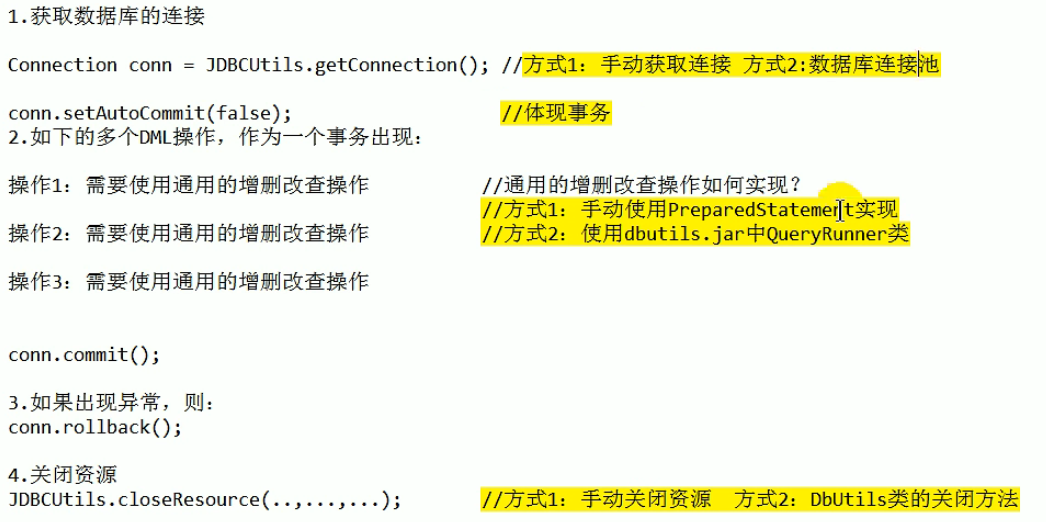
九、数据库连接池
必要性
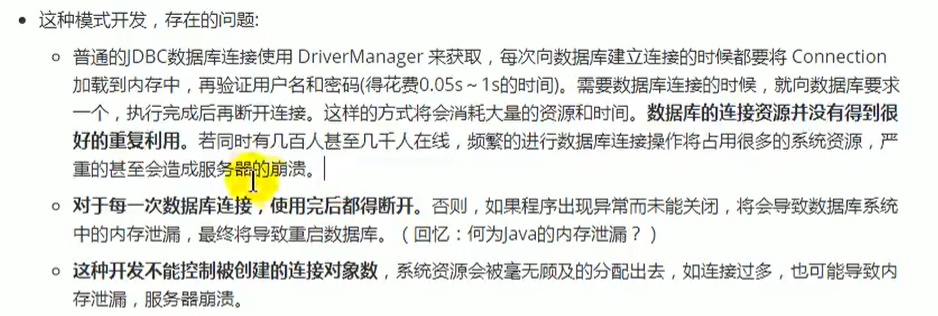
几种连接池
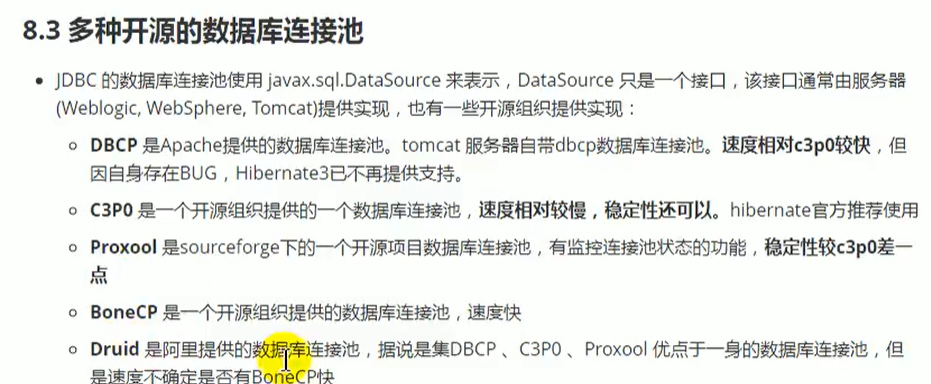
数据库连接池技术的优点
1. 资源重用
由于数据库连接得以重用,避免了频繁创建,释放连接引起的大量性能开销。在减少系统消耗的基础上,另一方面也增加了系统运行环境的平稳性。
2. 更快的系统反应速度
数据库连接池在初始化过程中,往往已经创建了若干数据库连接置于连接池中备用。此时连接的初始化工作均已完成。对于业务请求处理而言,直接利用现有可用连接,避免了数据库连接初始化和释放过程的时间开销,从而减少了系统的响应时间
3. 新的资源分配手段
对于多应用共享同一数据库的系统而言,可在应用层通过数据库连接池的配置,实现某一应用最大可用数据库连接数的限制,避免某一应用独占所有的数据库资源
4. 统一的连接管理,避免数据库连接泄漏
在较为完善的数据库连接池实现中,可根据预先的占用超时设定,强制回收被占用连接,从而避免了常规数据库连接操作中可能出现的资源泄露